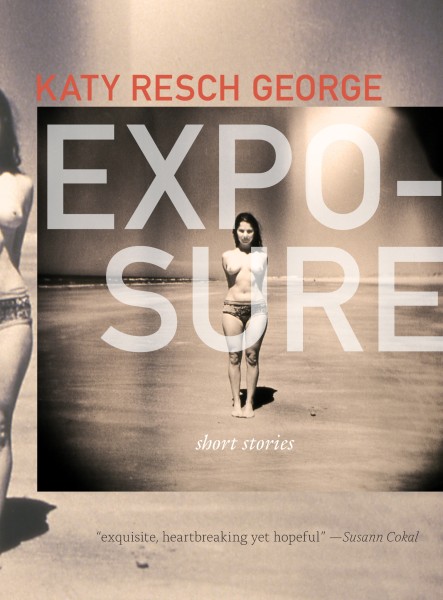
According to Webster’s Dictionary, there are generally three commonly used meanings for the word “Exposure:”
- “the fact or condition of being affected by something or experiencing something: the condition of being exposed to something;”
- “the act of revealing secrets about someone or something, and”
- “public attention and notice.”
Katy Resch George’s collection entitled Exposure aptly captures each definition within several beautifully layered stories. The collection contains ten stories of varied length, each story attempting to reveal or expose the characters, starting with the title piece that appeared in issue thirty-three of SmokeLong Quarterly.
I spoke with Katy via email to ask her about the collection, what inspires her, and the literary quality of photography.
Here’s our chat:
Tyrese: I know this may sound biased, but one of my favorite stories in the collection is “Exposure,” the one that appeared in SLQ. What I truly appreciate about this story is how seamless the transition between the characters is in such a short space. Why did you choose this story as the title piece of your collection? What does this story reveal about the collection itself?
KRG: I’m so glad you enjoyed this story. I was thrilled when SLQ published it. One reason I selected “Exposure” to frame the whole collection is because of that moment in the final paragraph, when the nurse is in the movie theater and observes the couple holding hands. She thinks: “… to hold hands in a theater is to say I am watching this movie, but I am also in this life that I share with this person; I bring this life with me wherever I go.” This idea that we contain many lives, or selves, and that we tote them around with us is one that touches nearly all the characters in the collection. Most characters in these stories are trying to reconcile past mistakes, past selves, with their current station, and with their wishes for their future. Often, this process is the heart of the story. To go through it, characters endure a variety of emotional exposures: they have to confront their whole selves– be exposed before themselves, if you will– in order to know why they behave as they do, and what they need to let go of.
Even though “Exposure” is short, it contains some detail that connects directly to all the other stories: a storm, sibling interactions, out-of-season death (and attempting to makes sense of it), making out in (semi) public places, wearing high-heels and its implications about feminine effort, marriage and the power of union, the playing-out of pathologies. There might be more! It was fun to discover those connections.
Also, the word “ exposure” draws attention to a central metaphor in the book, which involves the photographic process of capturing the accumulation of time through long film exposures.
I also think the form of the story– flash fiction but involving multiple characters and circumstances– prepares the reader for what’s coming: a mix of flash fictions and layered, lengthier stories.
Tyrese: Now that you mention it, I can see that thread of a photographic exposure weaved throughout your stories. Yet another definition of that term that is at play. The instant capture of life as we know it, so layered yet so simple is a hard concept to put down on paper, and I think you do this very well. I feel like this is the type of interpretation that only someone who knows about this type of exposure can pull off. Are you a photographer as well as a writer?
KRG: Many years ago photography was a hobby of mine. I satisfied some high school and college electives with photo classes and in college I worked in the darkroom mixing chemicals for the photo students. I loved capturing images but darkroom processes were tedious for me, though I had, and still have, romantic notions about them. I wanted to love it and I so admire photographers who get it.
Tyrese: Along this vein, another story I really enjoyed is “The Last Darkroom.” I thought the ending was particularly interesting as it left me with optimism, despite what we know about the main character’s circumstances and what lies in his immediate future. I love a short story that ends on a positive note, and I find that many writers are almost afraid to do this with contemporary short stories. Do you agree? Can you tell me about how you developed this story and what made you decide to end on such a hopeful tone?
KRG: Wow, thank you. I agree “The Last Darkroom” is especially hopeful at the end. Really, almost all of the stories are ultimately hopeful stories. I mentioned earlier that a lot of the stories show us characters’ efforts to realize a “better” self they want to become. Most of the characters make it, or the story ends with a character behaving in a new way that suggests she is on the right path. “The Last Darkroom” does this in the most clear and heartening way.
I can’t say if writers are afraid to end with optimism. I’m trying now to recall recent stories I’ve read that struck me as hopeful or optimistic and I’m struggling to come up with titles. That might say more about my tastes as a reader than it does about contemporary literary trends. Maybe writers—all people—don’t feel especially optimistic these days, or maybe people turn to the literary arts to exorcise fears or negativity to make room for optimism in their lives off the page. I’m speculating, of course. Maybe authors fear their optimistic endings would come off as saccharine? It could be a worthwhile exercise to draft two endings for a story in progress, both plausible yet surprising, but one grim and one hopeful. And see what feels most true to the characters and what the story needs to say.
“The Last Darkroom” began with the urge to write about people who were alienated and frustrated by modernity, really…people who felt a more “hands-on” approach to life was fading away. This pops up in the story with the darkroom vs. the digital lab, the narrator’s confusion about social media and his love of old cameras, and with his wife’s criticism of education being shrunken and dehumanized by standardized testing. Around the time I started toying with the story, I was thinking about what it would be like to become a parent and the story might be working through related anxieties Not only about physical health, but about new vulnerabilities and what would surely be a encompassing transition! (It has been– my daughter is now 17 months old!)
When I started the story I had no ending in mind—unusual for me. The narrative organically moved to a positive tone. I really loved writing that final scene. These characters, in their grief, had been removed from their vocations, from their marriage—they needed a break. The narrative also needed a break from the pile-up of misfortune, and it struck me as consistent with what we knew of the characters that they could find a way back to each other and their passion, at least for one evening.
Tyrese: What influenced your choice to include flash pieces along with stories of traditional lengths in one collection together? What are the advantages or disadvantages for the reader when digesting the collection as a whole?
KRG: This is a tough question! I collected these stories because they work as a unit to explore the themes I talked about earlier. I think if I tried to break apart “Exposure” and assemble two new collections– one of “traditional” length stories and one of flash fictions– I’d end up with two books investigating the same problems. As a writer and reader I love both forms. My intention was to let the flash fictions offer a more lyrical or formally experimental narrative exploration of themes presented in the lengthier works. Some readers might enjoy having these concentrated shots. But maybe some might find it jarring to go from a 7,000-word story that spans eight years to a 800-word story that covers one hour. I tried to arrange them to avoid that.
Tyrese: Are you working on any new projects?
KRG: Thanks for asking this. I am! I’m wrapping up a novel titled Lent that is about the emotionally fraught relationship of a young woman and her mentally ill mother. Part of the story takes place during the Easter season of Lent, which becomes significant as the young woman, in need of help for a number of reasons, is susceptible to charity that has bad strings attached. The other project is a story collection titled City Park that thinks about how operating out of our fears can make us dangerous.
 Katy Resch George’s stories have appeared in Blackbird, West Branch, Pank, Painted Bride Quarterly, and other journal and have been recognized by the annual Wigleaf Top 50 Very Short Fictions list and by the storySouth Million Writer’s Awards. She is a recipient of artist grants from the Barbara Deming Memorial Fund and Richmond Culture Works. Katy has taught for the English Departments of Brooklyn College and VCU, and as a faculty lecturer in the Expository Writing Program at New York University. She lives in Richmond, Virginia, with her husband visual artist Josh George and their daughter.
Katy Resch George’s stories have appeared in Blackbird, West Branch, Pank, Painted Bride Quarterly, and other journal and have been recognized by the annual Wigleaf Top 50 Very Short Fictions list and by the storySouth Million Writer’s Awards. She is a recipient of artist grants from the Barbara Deming Memorial Fund and Richmond Culture Works. Katy has taught for the English Departments of Brooklyn College and VCU, and as a faculty lecturer in the Expository Writing Program at New York University. She lives in Richmond, Virginia, with her husband visual artist Josh George and their daughter.
Tyrese L. Coleman is an associate editor with SmokeLong Quarterly.

 The core workshop of SmokeLong Fitness is all in writing, so you can take part from anywhere at anytime. We are excited about creating a supportive, consistent and structured environment for flash writers to work on their craft in a community. We are thrilled and proud to say that our workshop participants have won, placed, or been listed in every major flash competition. Community works.
The core workshop of SmokeLong Fitness is all in writing, so you can take part from anywhere at anytime. We are excited about creating a supportive, consistent and structured environment for flash writers to work on their craft in a community. We are thrilled and proud to say that our workshop participants have won, placed, or been listed in every major flash competition. Community works.